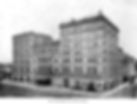Today in Brand History: The Metropolitan Opera House
- Rich Honiball
- Oct 22, 2022
- 3 min read

In 1883, New York's original Metropolitan Opera House has its grand opening with a performance of Charles Gounod's opera "Faust.” The “old Met” was located at 1411 Broadway, occupying the whole block between West 39th Street and West 40th Street on the west side of the street in the Garment District. The original Metropolitan Opera House, also called the “The Yellow Brick Brewery” because of its distinct exterior, was designed by J. Cleaveland Cady. A sidebar on Mr. Cady, born in Providence, RI in 1837, more than fifteen of his buildings are on the National Register of Historic Places. His work includes the American Museum of Natural History in NYC, the Brooklyn Academy of Design, and several different buildings for Trinity College, Yale University, Williams College, and Berea College. Cady is also the founder of the American Institute of Architects. Sadly, the original building was gutted by a fire in 1892. That season was cancelled while the opera house was rebuilt, however the Vaudeville Club, which eventually became the Metropolitan Opera Club started that year and hosted entertainment in the part of the building that was not damaged in the fire.

In 1903, architects John Carrere, born in Brazil, and Thomas Hastings, born in New York City, completed an extensive redesign of the interior of the opera house. Carrere and Hastings, known for their work on the New York Public Library, the House and Senate Office Buildings, and the Standard Oil Building added elements that completed the look of the old Metropolitan Opera House and were maintained until its closing.

In 1940, the ownership of the opera house was transferred from the wealthy families who occupied the theater's boxes to the non-profit Metropolitan Opera Association. The second
tier of privately held boxes was converted into standard row seating which enlarged the seating capacity and left only the first tier of boxes from the "golden horseshoe" of the opera house's origins as a showplace for New York society. At that point, the Met has a seating capacity of 3,625 with 224 standing room only spots.
While the theater was well known for its acoustics, over time the opera outgrew its facilities and plans were offered to move to various locations including the site where the Rockefeller Center now sits, Columbus Circle, and eventually what became its currently location, Lincoln Center. The final performance at the old Metropolitan Opera, a grand affair, was held on April 16th, 1966.

Planning for the new site began back in the 1920’s but construction didn’t start until the winter of 1963. The lead architect for the emerging Lincoln Center project, Wallace Harris, also let the design for the new Metropolitan Opera House. Harris is also credited with various major projects including the Rockefeller Center, the New York Hall of Science, and creating the master plan for Battery Park City. The first performance at the “new Met” was held on April 11th, 1966, though the official opening did not take place until several months later.
As for the original building, attempts were made to preserve it. It was purchased by Jack Weiler, a noted real estate developer and philanthropist, however when the building failed to obtain landmark status, it was demolished a year later. In its place, the 40 floor 1411 Building, which was intended to provide a steady stream of income for the Metropolitan Opera, was completed in 1970.

